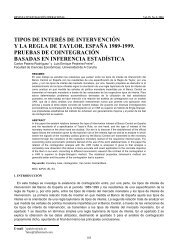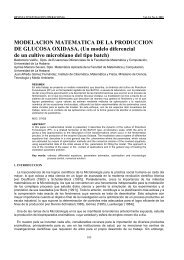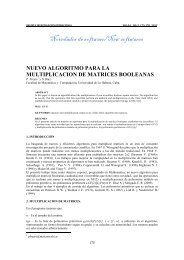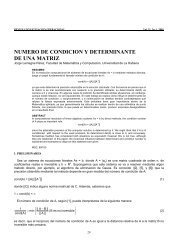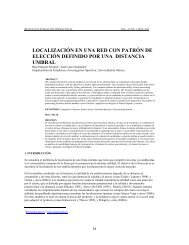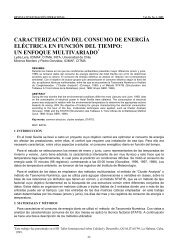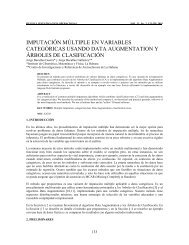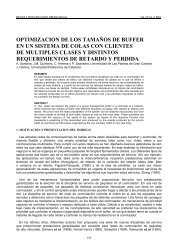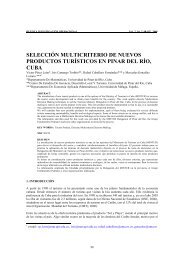una estrategia para la seleccion de modelos - revista investigación ...
una estrategia para la seleccion de modelos - revista investigación ...
una estrategia para la seleccion de modelos - revista investigación ...
Create successful ePaper yourself
Turn your PDF publications into a flip-book with our unique Google optimized e-Paper software.
REVISTA INVESTIGACION OPERACIONAL Vol. 21, No. 2, 2000<br />
UNA ESTRATEGIA PARA LA SELECCION DE MODELOS<br />
DE REGRESION CON DOS REGRESORES<br />
CUALITATIVOS<br />
Ernestina Castell Gil, Facultad <strong>de</strong> Matemática y Computacion, Universidad <strong>de</strong> La Habana<br />
1. INTRODUCCION<br />
RESUMEN<br />
En este artículo se propone <strong>una</strong> <strong>estrategia</strong> <strong>para</strong> <strong>la</strong> selección <strong>de</strong> mo<strong>de</strong>los <strong>de</strong> regresión con respuesta<br />
cuantitativa y dos regresores cualitativos. La propuesta se basa en <strong>la</strong> minimización <strong>de</strong> un estimador <strong>de</strong>l<br />
Cuadrado Medio <strong>de</strong>l Error <strong>de</strong> Predicción ( C M E P)<br />
<strong>de</strong>ntro <strong>de</strong> <strong>una</strong> c<strong>la</strong>se pre<strong>de</strong>finida <strong>de</strong> mo<strong>de</strong>los. Se<br />
consi<strong>de</strong>ran alg<strong>una</strong>s estructuras <strong>para</strong> <strong>la</strong>s interacciones entre <strong>la</strong>s que se encuentran <strong>la</strong>s propuestas por<br />
Man<strong>de</strong>l (1971) y Johnson y otros (1972), etc. Se proponen algunos gráficos <strong>para</strong> diagnosticar <strong>la</strong> forma<br />
<strong>de</strong> <strong>la</strong> interacción.<br />
Pa<strong>la</strong>bras c<strong>la</strong>ve: variables cualitativas, c<strong>la</strong>sificación doble, selección <strong>de</strong> mo<strong>de</strong>los.<br />
ABSTRACT<br />
In this methodological paper, a strategy for selection of regression mo<strong>de</strong>ls is proposed. The application<br />
is posible in situations with quantitative regressand and two qualitative regressors. The proposal is<br />
based on a minimization of an estimator of the Mean Square Error of Prediction ( C M E P)<br />
in certain<br />
pre<strong>de</strong>fined c<strong>la</strong>ss of mo<strong>de</strong>ls. Some structures for interaction (like in Man<strong>de</strong>l (1971) Johnson and others<br />
(1972)) are consi<strong>de</strong>red. Some graphical disp<strong>la</strong>ys for the form of interaction are also proposed.<br />
Key words: qualitative variable, two way c<strong>la</strong>sification, selection of mo<strong>de</strong>l.<br />
La forma tradicional <strong>de</strong> abordar el problema <strong>de</strong> regresión con dos regresores cualitativos es el <strong>de</strong> <strong>la</strong><br />
C<strong>la</strong>sificación Doble, don<strong>de</strong> <strong>de</strong>s<strong>de</strong> el comienzo mismo se asume un mo<strong>de</strong>lo como a<strong>de</strong>cuado y a posteriori se<br />
prueban <strong>de</strong>terminadas hipótesis <strong>para</strong> los parámetros con el objetivo <strong>de</strong> com<strong>para</strong>r los efectos <strong>para</strong> los<br />
diferentes niveles. En esa forma <strong>de</strong> abordar el problema no está presente <strong>la</strong> i<strong>de</strong>a <strong>de</strong> <strong>la</strong> selección <strong>de</strong>l mo<strong>de</strong>lo.<br />
Sean X1 y X2 dos variables cualitativas que pue<strong>de</strong>n tomar n 1 y n2<br />
valores categóricos diferentes<br />
respectivamente. Estas categorías serán <strong>de</strong>notadas por i1, i2,..., i e i′<br />
, i′<br />
,..., i′<br />
. Supóngase que se han<br />
realizado observaciones sobre <strong>una</strong> variable aleatoria cuantitativa Y en m = n1 × n2 puntos <strong>de</strong>l conjunto,<br />
{ ( i , i ) : 1 ≤ j ≤ n , 1 ≤ j′<br />
≤ n }<br />
j ′ j′<br />
1<br />
2<br />
.<br />
Sin pérdida <strong>de</strong> generalidad asumiremos n1= n 1 y n2= 2<br />
observaciones.<br />
i n ′ ′<br />
j j i<br />
Tradicionalmente se asume un mo<strong>de</strong>lo como el siguiente:<br />
( Yi<br />
) ji′<br />
j k μ<br />
′ i ji′<br />
= μ + α<br />
j′<br />
i + β<br />
j i′<br />
+ γ<br />
j′<br />
iji′<br />
j<br />
n1<br />
1<br />
2<br />
n2<br />
n , a<strong>de</strong>más en el punto ( , )<br />
i ′ ′ se realizan<br />
E = con (1.1)<br />
′<br />
n1<br />
n2<br />
αi =<br />
j ∑βi′<br />
j′<br />
n1<br />
= ∑ γiji′<br />
j′<br />
n2<br />
= ∑ γiji′<br />
j′<br />
j=<br />
1 j´<br />
= 1 j=<br />
1 j´<br />
= 1<br />
∑<br />
= 0<br />
145<br />
j ij
2<br />
Var ( Y i ) ji′<br />
j k = σ 1≤<br />
j ≤ n1,<br />
1≤<br />
j´<br />
≤ n2,<br />
1≤<br />
k ≤ n<br />
′<br />
iji′<br />
j′<br />
Las observaciones se asumen no corre<strong>la</strong>cionadas.<br />
Un mo<strong>de</strong>lo como el anterior está sobre<strong>para</strong>metrizado (contiene el número máximo <strong>de</strong> parámetros, esto es,<br />
n1 + n2 + (n1 × n2) + 1 parámetros), lo que implica <strong>una</strong> reducción en <strong>la</strong> precisión <strong>de</strong> <strong>la</strong>s estimaciones, pues <strong>la</strong><br />
varianza <strong>de</strong> los estimadores crece cuando crece el número <strong>de</strong> parámetros en el mo<strong>de</strong>lo.<br />
Se sabe que <strong>la</strong>s estimaciones mínimos cuadráticas en el mo<strong>de</strong>lo 1.1. son:<br />
n<br />
ni<br />
i′<br />
1 2 j j′<br />
∑ ∑ ∑<br />
1<br />
μˆ<br />
= YK<br />
=<br />
Yi<br />
ji′<br />
j´<br />
k<br />
(1.2)<br />
n<br />
j=<br />
1<br />
αˆ<br />
i = Yi<br />
.. − YK<br />
βˆ<br />
γˆ<br />
j<br />
i´<br />
j´<br />
i ji′<br />
j′<br />
j<br />
= Y.<br />
= Y<br />
i´<br />
j´<br />
i ji′<br />
j′<br />
.<br />
. − Y<br />
K<br />
n<br />
j´<br />
= 1<br />
con<br />
con<br />
k=<br />
1<br />
i′<br />
j′<br />
Y<br />
i ..<br />
j<br />
=<br />
Y.<br />
i´<br />
j´<br />
− Y .. − Y.<br />
. + Y...<br />
i j<br />
n<br />
1<br />
2<br />
∑<br />
n<br />
i i′<br />
j´<br />
= 1<br />
. =<br />
j j′<br />
1<br />
1<br />
∑<br />
n<br />
i i′<br />
2 j j′<br />
∑ ∑<br />
j´<br />
= 1<br />
n<br />
k=<br />
1<br />
n<br />
Y<br />
i i′<br />
k<br />
ni<br />
i′<br />
j j′<br />
1 j j′<br />
∑ ∑<br />
Y<br />
n<br />
iji′<br />
j′<br />
k<br />
niji′<br />
j′<br />
j=<br />
1 k = 1<br />
j=<br />
1<br />
con<br />
Y<br />
i ji′<br />
j′<br />
. =<br />
1<br />
n<br />
i ji′<br />
j′<br />
=<br />
∑ ′ niji′<br />
j<br />
k = 1<br />
Y<br />
i ji′<br />
j′<br />
k<br />
Estos estimadores poseen propieda<strong>de</strong>s interesantes pues son estimadores mínimos cuadráticos, (Scheffé,<br />
(1982)). La consi<strong>de</strong>ración <strong>de</strong> diferentes ecuaciones <strong>de</strong> regresión es equivalente a consi<strong>de</strong>rar diferentes<br />
particiones sobre el espacio <strong>de</strong> valores <strong>de</strong> los regresores. En el caso bien sencillo <strong>de</strong> n1 = 3 y n2 = 2 y <strong>la</strong>s<br />
interacciones iguales a cero (mo<strong>de</strong>lo aditivo). Las ecuaciones que <strong>de</strong>finen los mo<strong>de</strong>los posibles son:<br />
I. Mo<strong>de</strong>lo con un parámetro.<br />
g1(X1; X2) = μ<br />
II. Mo<strong>de</strong>los con dos parámetros.<br />
⎧ μ + α<br />
g2(<br />
X1;<br />
X2)<br />
= ⎨<br />
⎩ μ − α<br />
⎧ μ + α<br />
g3(<br />
X1;<br />
X2)<br />
= ⎨<br />
⎩ μ − α<br />
⎧ μ + α<br />
g4<br />
( X1;<br />
X2<br />
) = ⎨<br />
⎩ μ − α<br />
si<br />
si<br />
si<br />
si<br />
si<br />
si<br />
X = i , i ;<br />
1<br />
X = i ,<br />
1<br />
1<br />
3<br />
2<br />
X = i , i ;<br />
1<br />
X = i ;<br />
1<br />
X<br />
1<br />
2<br />
3<br />
= i ;<br />
X<br />
X<br />
X<br />
X<br />
X = i , i ;<br />
1<br />
1<br />
3<br />
1<br />
2<br />
2<br />
2<br />
2<br />
2<br />
= i1′<br />
, i′<br />
2.<br />
= i′<br />
, i′<br />
.<br />
1<br />
2<br />
= i1′<br />
, i′<br />
2.<br />
= i′<br />
, i′<br />
.<br />
X<br />
X<br />
2<br />
2<br />
1<br />
2<br />
= i1′<br />
, i′<br />
2.<br />
= i′<br />
, i′<br />
.<br />
1<br />
2<br />
146
⎩<br />
⎨<br />
⎧<br />
′<br />
=<br />
=<br />
β<br />
−<br />
μ<br />
′<br />
=<br />
=<br />
β<br />
+<br />
μ<br />
=<br />
.<br />
i<br />
X<br />
;<br />
i<br />
,<br />
i<br />
,<br />
i<br />
X<br />
si<br />
.<br />
i<br />
X<br />
;<br />
i<br />
,<br />
i<br />
,<br />
i<br />
X<br />
si<br />
)<br />
X<br />
;<br />
X<br />
(<br />
g<br />
2<br />
2<br />
3<br />
2<br />
1<br />
1<br />
1<br />
2<br />
3<br />
2<br />
1<br />
1<br />
2<br />
1<br />
5<br />
147
III. Mo<strong>de</strong>los con tres parámetros.<br />
⎧ μ + α i1′<br />
⎪<br />
g6<br />
( X1;<br />
X2<br />
) = ⎨ μ + α i′<br />
2<br />
⎪<br />
⎩<br />
μ − α i′<br />
− α<br />
1<br />
⎧ μ + α + β<br />
⎪<br />
μ + α − β<br />
g7(<br />
X1;<br />
X2<br />
) = ⎨<br />
⎪ μ + β − α<br />
⎪<br />
⎩ μ − α − β<br />
⎧ μ + α + β<br />
⎪<br />
μ + α − β<br />
g8(<br />
X1;<br />
X2<br />
) = ⎨<br />
⎪ μ + β − α<br />
⎪<br />
⎩ μ − α − β<br />
⎧ μ + α + β<br />
⎪<br />
μ + α − β<br />
g9(<br />
X1;<br />
X2<br />
) = ⎨<br />
⎪ μ + β − α<br />
⎪<br />
⎩ μ − α − β<br />
si<br />
si<br />
si<br />
si<br />
si<br />
si<br />
si<br />
si<br />
si<br />
si<br />
si<br />
si<br />
i′<br />
2<br />
si<br />
si<br />
si<br />
X<br />
1<br />
1<br />
1<br />
X = i ;<br />
X = i ;<br />
= i ;<br />
1<br />
X = i ;<br />
2<br />
X = i ;<br />
X = i , i ;<br />
1<br />
X = i , i ;<br />
1<br />
1<br />
1<br />
1<br />
1<br />
3<br />
3<br />
2<br />
2<br />
X = i , i ;<br />
1<br />
X = i , i ;<br />
1<br />
X = i ;<br />
1<br />
X = i ;<br />
IV. Mo<strong>de</strong>lo con cuatro parámetros.<br />
g<br />
10<br />
X<br />
X<br />
⎧ μ + αi<br />
+ β<br />
1′<br />
⎪<br />
⎪<br />
μ + αi<br />
− β<br />
1′<br />
⎪ μ + α i′<br />
+ β<br />
2<br />
( X1;<br />
X2<br />
) = ⎨<br />
⎪<br />
μ + α i′<br />
− β<br />
2<br />
⎪ μ + β − αi′<br />
− α<br />
1<br />
⎪<br />
⎪⎩<br />
μ − β − α i′<br />
− α<br />
1<br />
1<br />
1<br />
1<br />
2<br />
2<br />
= i ;<br />
= i ;<br />
3<br />
3<br />
X = i , i ;<br />
1<br />
X = i , i ;<br />
1<br />
1<br />
1<br />
i′<br />
2<br />
i′<br />
2<br />
2<br />
2<br />
1<br />
1<br />
si<br />
si<br />
si<br />
si<br />
si<br />
si<br />
3<br />
3<br />
X<br />
X<br />
3<br />
1<br />
1<br />
X<br />
X<br />
X<br />
X<br />
X<br />
X<br />
X<br />
X<br />
X<br />
X<br />
X<br />
X<br />
2<br />
2<br />
2<br />
2<br />
2<br />
2<br />
2<br />
2<br />
2<br />
2<br />
2<br />
2<br />
X<br />
X<br />
X<br />
2<br />
2<br />
2<br />
= i1′<br />
.<br />
= i′<br />
2.<br />
= i1′<br />
.<br />
= i′<br />
.<br />
2<br />
= i1′<br />
.<br />
= i′<br />
2.<br />
= i1′<br />
.<br />
= i′<br />
.<br />
= i ;<br />
= i ;<br />
2<br />
= i1′<br />
.<br />
= i′<br />
2.<br />
= i1′<br />
.<br />
= i′<br />
.<br />
X = i ;<br />
1<br />
X = i ;<br />
1<br />
X = i ;<br />
1<br />
X = i ;<br />
1<br />
1<br />
1<br />
2<br />
2<br />
3<br />
3<br />
2<br />
= i1′<br />
, i′<br />
2.<br />
= i1′<br />
, i′<br />
2.<br />
= i′<br />
, i′<br />
X<br />
X<br />
X<br />
X<br />
X<br />
X<br />
1 2.<br />
2<br />
2<br />
2<br />
2<br />
2<br />
2<br />
= i1′<br />
.<br />
= i′<br />
2.<br />
= i1′<br />
.<br />
= i′<br />
2.<br />
= i1′<br />
.<br />
= i′<br />
.<br />
El número <strong>de</strong> parámetros en el mo<strong>de</strong>lo crece al crecer el número <strong>de</strong> c<strong>la</strong>ses en <strong>la</strong> partición que el mo<strong>de</strong>lo<br />
induce en el espacio <strong>de</strong> valores X = X1 × X2.<br />
Contar el número <strong>de</strong> mo<strong>de</strong>los con p parámetros sería equivalente a contar <strong>la</strong>s particiones don<strong>de</strong> <strong>la</strong> suma<br />
<strong>de</strong> los números <strong>de</strong> c<strong>la</strong>ses <strong>de</strong> <strong>la</strong>s particiones en los espacios <strong>de</strong> valores <strong>de</strong> X1 y X2 sea igual a p + 1.<br />
Proposición 1.1.<br />
Sean X1 y X2 dos variables cualitativas con n1 y n2 valores diferentes (n1 ≤ n2). Entonces existen:<br />
Min(<br />
n , p)<br />
1<br />
∑<br />
a=<br />
p+<br />
1−Min(<br />
n2,<br />
p)<br />
⎧<br />
⎪<br />
⎡<br />
⎨ ⎢<br />
⎪⎩<br />
⎢<br />
⎣<br />
a<br />
∑<br />
j=<br />
1<br />
a−<br />
j<br />
( −1)<br />
j!<br />
( a − j)!<br />
n1<br />
j<br />
⎤ ⎡<br />
⎥ ⎢<br />
⎥ ⎢<br />
⎦ ⎣<br />
p+<br />
1−a<br />
∑<br />
j=<br />
1<br />
p+<br />
1−a−<br />
j<br />
( −1)<br />
j!<br />
( p + 1−<br />
a − j)!<br />
mo<strong>de</strong>los aditivos diferentes con p parámetros.<br />
Demostración:<br />
n2<br />
j<br />
Se sabe que si X es <strong>una</strong> variable cualitativa con m categorías diferentes, el número <strong>de</strong> mo<strong>de</strong>los con p<br />
parámetros (número <strong>de</strong> particiones con p c<strong>la</strong>ses) es:<br />
2<br />
⎤ ⎫<br />
⎥<br />
⎪<br />
⎬<br />
⎥<br />
⎦ ⎪⎭<br />
148<br />
(1.3)
p<br />
∑<br />
j=<br />
1<br />
p−<br />
j<br />
( −1)<br />
j!<br />
( p − j)!<br />
j<br />
m<br />
((Kovacs (1980); Bunke y Castell (1998)).<br />
H<br />
H<br />
Por tanto, <strong>la</strong>s cantida<strong>de</strong>s,<br />
1<br />
2<br />
=<br />
=<br />
a<br />
∑<br />
j=<br />
1<br />
∑ − + p 1 a<br />
j=<br />
1<br />
a−<br />
j<br />
( −1)<br />
j!<br />
( a − j)!<br />
n1<br />
j<br />
p+<br />
1−a<br />
− j<br />
( −1)<br />
j!<br />
( p + 1−<br />
a − j)!<br />
n2<br />
j<br />
representan el número <strong>de</strong> particiones con a c<strong>la</strong>ses en el espacio <strong>de</strong> valores <strong>de</strong> X1 y con p + 1 - a c<strong>la</strong>ses en el<br />
espacio <strong>de</strong> valores <strong>de</strong> X2; siendo su suma igual a p + 1.<br />
Si M es un mo<strong>de</strong>lo aditivo <strong>de</strong>finido por <strong>la</strong> ecuación que induce particiones como <strong>la</strong>s consi<strong>de</strong>radas, este<br />
tendrá p parámetros.<br />
Para a fijo, cada partición con a c<strong>la</strong>ses en el espacio <strong>de</strong> valores <strong>de</strong> X1 se combina con cada <strong>una</strong> <strong>de</strong> <strong>la</strong>s H2<br />
particiones con p + 1 - a c<strong>la</strong>ses en el espacio <strong>de</strong> valores <strong>de</strong> X2, es <strong>de</strong>cir, <strong>para</strong> a fijo el número <strong>de</strong> mo<strong>de</strong>los<br />
con p parámetros será H = H1.H2. Pero el número <strong>de</strong> c<strong>la</strong>ses <strong>de</strong> <strong>la</strong>s particiones en el espacio <strong>de</strong> valores <strong>de</strong> X1<br />
pue<strong>de</strong> ser como mínimo igual a p + 1 - Min(n2,p) y a lo sumo Min(n1,p). Sumando ahora <strong>para</strong> todo valor <strong>de</strong> a<br />
posible se obtiene <strong>la</strong> fórmu<strong>la</strong> dada en 1.3.<br />
La cantidad <strong>de</strong> mo<strong>de</strong>los aditivos servirá como referencia <strong>para</strong> valorar cuan gran<strong>de</strong> es <strong>la</strong> cantidad <strong>de</strong><br />
mo<strong>de</strong>los posibles.<br />
2. MODELACION DE LAS INTERACCIONES<br />
Cuando se trabaja con dos regresores cualitativos y se quiere realizar un análisis completo es necesario<br />
<strong>de</strong>terminar <strong>la</strong> presencia o no <strong>de</strong>l término <strong>de</strong> interacción y estimar <strong>la</strong> varianza. El mo<strong>de</strong>lo usual con<br />
interacciones está sobre<strong>para</strong>metrizado y como ya se mencionó esto es un gran inconveniente. La<br />
consi<strong>de</strong>ración <strong>de</strong> <strong>de</strong>terminadas formas <strong>de</strong> interacciones (Man<strong>de</strong>l (1961) y (1971); Johnson y Graybill (1972);<br />
Darroch y Speed (1983); Wilhelm (1985); Huet (1991)) produce <strong>una</strong> disminución <strong>de</strong>l número <strong>de</strong> parámetros.<br />
Esta consi<strong>de</strong>ración es tremendamente importante cuando se tiene <strong>una</strong> so<strong>la</strong> observación por combinaciones<br />
<strong>de</strong> los tratamientos, porque entonces no se pue<strong>de</strong> utilizar <strong>la</strong> teoría clásica <strong>de</strong> los mo<strong>de</strong>los lineales, ya que <strong>la</strong><br />
estimación <strong>de</strong> <strong>la</strong> varianza <strong>de</strong>l error tiene que obtenerse <strong>de</strong> <strong>la</strong> suma <strong>de</strong> cuadrados <strong>de</strong> <strong>la</strong>s interacciones.<br />
Los diferentes mo<strong>de</strong>los que se proponen consi<strong>de</strong>rar (Man<strong>de</strong>l (1961) y (1971); Johnson y Graybill (1972);<br />
Milliken y Graybill (1970); Wilhelm (1985) y otros) son:<br />
1. Mo<strong>de</strong>lo aditivo<br />
Y = μ + α + β + ε ′<br />
iji′ j′<br />
k ij<br />
i′<br />
j′<br />
iji′<br />
j k<br />
2. Mo<strong>de</strong>lo concurrente<br />
Y = μ + α + β + λα β + ε ′<br />
iji′ j′<br />
k ij<br />
i′<br />
j′<br />
ij<br />
i′<br />
j′<br />
iji′<br />
j k<br />
3. Mo<strong>de</strong>lo <strong>de</strong> regresión por columna.<br />
Y = μ + α + β + θ β + ε = μ + α + β ( 1+<br />
θ ) + ε ′<br />
iji′ j′<br />
k ij<br />
i′<br />
j′<br />
ij<br />
i′<br />
j′<br />
iji′<br />
j′<br />
k ij<br />
i′<br />
j′<br />
ij<br />
iji′<br />
j k<br />
149
4. Mo<strong>de</strong>lo <strong>de</strong> regresión por fi<strong>la</strong>.<br />
Y = μ + α + β + ϑ α + ε = μ + ( ϑ + 1)<br />
α + β + ε ′<br />
iji′ j′<br />
k ij<br />
i′<br />
j′<br />
i′<br />
j′<br />
ij<br />
iji′<br />
j′<br />
k<br />
i′<br />
j′<br />
ij<br />
i′<br />
j′<br />
iji′<br />
j k<br />
5. Quinto mo<strong>de</strong>lo.<br />
Y = μ + α + β + λθα ϑ + ε ′<br />
i ji′<br />
j´<br />
k i j i′<br />
j´<br />
i j i′<br />
j´<br />
i ji<br />
j´<br />
k<br />
6. Mo<strong>de</strong>lo <strong>de</strong> Man<strong>de</strong>l.<br />
t<br />
Y i′<br />
k = μ + αi<br />
+ βi<br />
lUli<br />
Vli<br />
i i k 0 ≤ t ≤ Min(n<br />
′<br />
′ + λ<br />
′ ∑ ′ + ε ′ ′ ′<br />
1,n2)<br />
ij j<br />
j j<br />
j j j j<br />
7. Séptimo mo<strong>de</strong>lo.<br />
l=<br />
1<br />
Y = μ + α + β + λα β + θ β + ε ′<br />
iji′ j′<br />
k ij<br />
i′<br />
j′<br />
ij<br />
i′<br />
j′<br />
ij<br />
i′<br />
j′<br />
iji′<br />
j k<br />
8. Octavo mo<strong>de</strong>lo.<br />
Y = μ + α + β + λα β + ϑ α + ε ′<br />
iji′ j′<br />
k ij<br />
i′<br />
j′<br />
ij<br />
i′<br />
j′<br />
i′<br />
j′<br />
ij<br />
iji′<br />
j k<br />
9. Noveno mo<strong>de</strong>lo.<br />
Y = μ + α + β + λα β + θ β + ϑ α + ε ′<br />
i ji′<br />
j′<br />
k i j i′<br />
j′<br />
i j i′<br />
j′<br />
i j i′<br />
j´<br />
i′<br />
j′<br />
i j i ji′<br />
j k<br />
10. Décimo mo<strong>de</strong>lo.<br />
Y = μ + α + β + γ + ε ′<br />
iji′ j′<br />
k ij<br />
i′<br />
j′<br />
iji′<br />
j′<br />
iji′<br />
j k<br />
n<br />
∑<br />
Sujetos a <strong>la</strong>s restricciones<br />
n<br />
1<br />
2<br />
1<br />
2<br />
α i =<br />
j ∑βi′<br />
=<br />
j ∑θi<br />
=<br />
j ∑ϑ<br />
′<br />
i′<br />
j′<br />
j=<br />
1<br />
n<br />
j=<br />
1<br />
j´<br />
= 1<br />
n<br />
n<br />
j=<br />
1<br />
n<br />
j´<br />
= 1<br />
1<br />
2<br />
2 2 2 2<br />
∑ i j ∑ j ∑ j ∑ j<br />
1<br />
∑<br />
= 0<br />
θ = ϑi′<br />
= Uli<br />
= Vli′<br />
= 1<br />
′<br />
′<br />
j´<br />
= 1<br />
n<br />
γ iji′<br />
j′<br />
n2<br />
= ∑ γi<br />
ji′<br />
j′<br />
j=<br />
1 j´<br />
= 1<br />
l=<br />
1<br />
= 0<br />
l=<br />
1<br />
El número <strong>de</strong> parámetros en cualquier mo<strong>de</strong>lo <strong>de</strong> los enumerados anteriormente, será igual al número <strong>de</strong><br />
parámetros <strong>de</strong>l mo<strong>de</strong>lo aditivo contenido en él, más el número <strong>de</strong> parámetros que aportan <strong>la</strong>s interacciones.<br />
3. UNA ESTRATEGIA PARA LA SELECCION DEL MODELO<br />
Se consi<strong>de</strong>ra que se realizan observaciones Y i′<br />
k sobre <strong>una</strong> variable aleatoria Y, que satisfacen <strong>la</strong> ecuación<br />
′<br />
<strong>de</strong> regresión:<br />
( ij,<br />
i′<br />
j′<br />
) + εi<br />
i′<br />
k<br />
iji′ j′<br />
k<br />
j j<br />
i j j<br />
Y = f<br />
(3.1)<br />
′<br />
150
2<br />
Se supone que ε son errores aleatorios (no observables) con esperanza cero y varianza σ y que están<br />
incorre<strong>la</strong>cionados.<br />
La función f ( , )<br />
j ij<br />
i k ′<br />
ij j′<br />
i ′ ′ pertenece a un conjunto M <strong>de</strong>finido por:<br />
M = {g(X1,X2,β): β ∈ β} (3.2)<br />
con<br />
∑<br />
g(x1,x2,β) = 1 g ( x1,<br />
x2<br />
) i i<br />
(3.3)<br />
′ ′ ′ μ<br />
r<br />
Cr<br />
β t = ( μ , α , α ,..., α M β ′ , β ′ ,..., β ′ M γ , γ ,..., γ )<br />
i 1<br />
i2<br />
ip1<br />
i1<br />
j j<br />
i2<br />
i2<br />
1<br />
2<br />
p3<br />
don<strong>de</strong><br />
j j i i l l ′ ′ ∀ γ = γ <strong>para</strong> algún ( ij<br />
; ij′<br />
) y es cualquiera <strong>de</strong> los tipos <strong>de</strong> interacciones <strong>de</strong>scritos y<br />
está dada por <strong>una</strong> <strong>de</strong> <strong>la</strong>s expresiones <strong>de</strong> <strong>la</strong> (1) a <strong>la</strong> (10) dadas anteriormente.<br />
′<br />
μ<br />
N =<br />
U<br />
r<br />
Así que <strong>la</strong> selección <strong>de</strong>l mo<strong>de</strong>lo viene dada por <strong>la</strong> selección <strong>de</strong> <strong>una</strong> función g en M <strong>para</strong> aproximar f. El<br />
conjunto <strong>de</strong> observaciones será utilizado <strong>para</strong> calcu<strong>la</strong>r un estimador βˆ <strong>de</strong>l vector <strong>de</strong> parámetros β y<br />
<strong>seleccion</strong>ar <strong>una</strong> función g(X1,X2,<br />
β ˆ ).<br />
En <strong>la</strong> selección <strong>de</strong> <strong>la</strong> función g(X1,X2, β ˆ ) se utilizará el criterio <strong>de</strong> minimización <strong>de</strong> un estimador <strong>de</strong>l CMEP o<br />
<strong>de</strong>l CME. El vector <strong>de</strong> parámetros β será estimado por el Método <strong>de</strong> los Mínimos Cuadrados.<br />
En <strong>la</strong> primera etapa <strong>de</strong> <strong>la</strong> <strong>estrategia</strong> se analizarán los mo<strong>de</strong>los con un número <strong>de</strong> parámetros inferior o<br />
igual a un número p0 fijado por el usuario apropiadamente y <strong>de</strong>ntro <strong>de</strong> los límites permisibles. Posteriormente<br />
hay que encontrar <strong>una</strong> manera <strong>de</strong> reducir el número <strong>de</strong> mo<strong>de</strong>los a com<strong>para</strong>r y <strong>la</strong> i<strong>de</strong>a sería hacer <strong>una</strong><br />
reducción <strong>de</strong> forma tal que entre un paso y otro <strong>de</strong> <strong>la</strong> <strong>estrategia</strong> los mo<strong>de</strong>los analizados no cambien<br />
bruscamente en cuanto al número <strong>de</strong> parámetros. En <strong>la</strong> consecución <strong>de</strong> este último objetivo juega un rol<br />
fundamental el concepto <strong>de</strong> mo<strong>de</strong>lo vecino que se da más a<strong>de</strong><strong>la</strong>nte.<br />
Definición 3.1. (mo<strong>de</strong>lo vecino)<br />
Sea,<br />
δ ∈ {α; β; γ(X1,X2)}<br />
Sea M0 un mo<strong>de</strong>lo. Sea π0 <strong>la</strong> partición <strong>de</strong>terminada por <strong>la</strong> función g0(X1, X2, β) que <strong>de</strong>fine al mo<strong>de</strong>lo M0.<br />
δ<br />
Mv 0 según δ, si se cumple:<br />
Sean Cok <strong>la</strong>s c<strong>la</strong>ses <strong>de</strong> esta partición. Se dice que es un mo<strong>de</strong>lo vecino <strong>de</strong> M<br />
1. Existe un y sólo un δ y <strong>una</strong> y so<strong>la</strong>mente <strong>una</strong> c<strong>la</strong>se Cok tal que:<br />
Cok = (Cvk´) δ ∪ (Cvk´´) δ<br />
don<strong>de</strong> se ha utilizado el supraíndice δ <strong>para</strong> indicar que se afecta <strong>la</strong> c<strong>la</strong>se sólo según ese parámetro.<br />
2. Para todo r ≠ k existe r´, tal que k´≠ r´≠ k´´, <strong>para</strong> el cual se cumple:<br />
Cor = (Cvr) δ<br />
151<br />
C<br />
g<br />
r<br />
j j i i ′ ′
δ<br />
3. A<strong>de</strong>más <strong>la</strong> forma <strong>de</strong> <strong>la</strong> interacción <strong>de</strong>l mo<strong>de</strong>lo Mv es <strong>la</strong> misma que <strong>la</strong> <strong>de</strong>l mo<strong>de</strong>lo M0.<br />
Por <strong>la</strong> forma en que se ha <strong>de</strong>finido el mo<strong>de</strong>lo vecino, es intuitivamente c<strong>la</strong>ro que, este tiene un parámetro<br />
más que M0.<br />
En un problema con dos variables cualitativas existen tres nominaciones <strong>de</strong> parámetros, que se han<br />
venido representando así:<br />
α → niveles <strong>de</strong> <strong>la</strong> primera variable<br />
β → niveles <strong>de</strong> <strong>la</strong> segunda variable<br />
γ → interacciones<br />
Para construir <strong>una</strong> <strong>estrategia</strong> <strong>de</strong> selección, basándose en los mo<strong>de</strong>los vecinos hay que <strong>de</strong>cidir en qué<br />
or<strong>de</strong>n se toman <strong>la</strong>s nominaciones <strong>para</strong> ir aumentando <strong>la</strong> cantidad <strong>de</strong> parámetros en el mo<strong>de</strong>lo. Como no hay<br />
preferencia entre un factor u otro, este or<strong>de</strong>n es irrelevante. Como hay que <strong>de</strong>cidirse por un or<strong>de</strong>n, se<br />
propone: α → β → γ.<br />
3.1. Estrategia <strong>para</strong> <strong>la</strong> selección <strong>de</strong>l mo<strong>de</strong>lo<br />
Sea γl(X1,X2) <strong>la</strong> forma <strong>de</strong> interacción en el mo<strong>de</strong>lo Ml(⋅), l = 1,2,...,10. Sea p(l) el número máximo <strong>de</strong><br />
parámetros permisibles <strong>para</strong> el mo<strong>de</strong>lo Ml(⋅).<br />
Sea<br />
0<br />
M l = {(Ml(p): p ≤ p0; 1 ≤ p0 ≤ p(l)}<br />
rˆ<br />
Sea<br />
( M (p) ) rˆ ( l, p(l) )<br />
l =<br />
un estimador <strong>de</strong>l CMEP <strong>para</strong> el mo<strong>de</strong>lo Ml(p).<br />
1. Calcu<strong>la</strong>r el número <strong>de</strong> mo<strong>de</strong>los aditivos posibles <strong>para</strong> cada p = 1,2,...,p(l). Siendo l un número fijo.<br />
2. De acuerdo a lo <strong>de</strong>terminado en el punto anterior, a <strong>la</strong>s facilida<strong>de</strong>s <strong>de</strong> cómputo y al tiempo y esfuerzo que<br />
0<br />
se esté dispuesto a emplear, <strong>seleccion</strong>ar un valor p0 y así quedará <strong>de</strong>terminado el conjunto M l que<br />
l<strong>la</strong>maremos conjunto <strong>de</strong> mo<strong>de</strong>los básicos.<br />
En lo que sigue se utilizará <strong>la</strong> siguiente notación, por ejemplo ( ) α 0<br />
M es un mo<strong>de</strong>lo vecino <strong>de</strong> M según <strong>la</strong>s<br />
particiones correspondientes al parámetro α. Es <strong>de</strong>cir, se ha aumentado un parámetro con respecto al<br />
0<br />
número que contenía M pero el aumento se hace en <strong>la</strong> <strong>de</strong>nominación α. La c<strong>la</strong>se formada por los vecinos<br />
0<br />
l<br />
l<br />
v, α<br />
l<br />
<strong>de</strong> M según el parámetro α, se <strong>de</strong>notará por M .<br />
Realizar los siguientes pasos:<br />
1. Determinar<br />
M<br />
0<br />
l<br />
= ArgMin rˆ ( l,<br />
p)<br />
0<br />
M∈M<br />
l<br />
152<br />
l<br />
v<br />
0<br />
l
Sea<br />
M<br />
0<br />
l =<br />
M<br />
0<br />
l<br />
( p´)<br />
don<strong>de</strong> p´ representa <strong>la</strong> cantidad <strong>de</strong> parámetros en<br />
2. Sea<br />
Determinar<br />
entonces<br />
3. Sea<br />
Determinar<br />
4. Sea<br />
Determinar<br />
5. Sea<br />
Determinar<br />
6. Sea<br />
Determinar<br />
7. Sea<br />
Determinar<br />
M<br />
M<br />
M<br />
M<br />
M<br />
M<br />
M<br />
M<br />
M<br />
M<br />
M<br />
M<br />
M<br />
v, α<br />
l<br />
1,<br />
α<br />
l<br />
1,<br />
α<br />
l<br />
v,<br />
β<br />
l<br />
2,<br />
β<br />
l<br />
=<br />
⎧<br />
⎨<br />
⎩<br />
( ) ⎬<br />
⎭ ⎫ 0 α<br />
M<br />
l<br />
v<br />
= ArgMin rˆ ( l,<br />
p´<br />
+ 1)<br />
= M<br />
v,<br />
α<br />
M∈M<br />
l<br />
=<br />
⎧<br />
⎨<br />
⎩<br />
1,<br />
α<br />
l<br />
( p´<br />
+ 1)<br />
( ) ⎬<br />
⎭ ⎫ , α β<br />
M<br />
1 l<br />
= ArgMin rˆ ( l,<br />
p´<br />
+ 2)<br />
v,<br />
β<br />
M∈M<br />
l<br />
=<br />
⎧<br />
⎨<br />
⎩<br />
v<br />
2,<br />
β ( )<br />
v,<br />
γ ( X1,<br />
X2<br />
)<br />
l<br />
Ml<br />
γ<br />
3,<br />
( X1,<br />
X2<br />
)<br />
l<br />
v, α<br />
l<br />
4,<br />
α<br />
l<br />
v,<br />
β<br />
l<br />
5,<br />
α<br />
l<br />
=<br />
⎧<br />
⎨<br />
⎩<br />
=<br />
ArgMin<br />
v,<br />
γ(<br />
X1,<br />
X2<br />
)<br />
M∈M<br />
l<br />
γ(<br />
X1,<br />
X2<br />
)<br />
v<br />
( ) ⎬<br />
⎭ ⎫<br />
3,<br />
γ(<br />
X , X ) α<br />
1 2 M<br />
l<br />
= ArgMin rˆ ( l,<br />
p´<br />
+ 4)<br />
=<br />
⎧<br />
⎨<br />
⎩<br />
v,<br />
α<br />
M∈M<br />
l<br />
( ) ⎬<br />
⎭ ⎫ 4,<br />
α β<br />
M<br />
l<br />
= ArgMin rˆ ( l,<br />
p´<br />
+ 5)<br />
v,<br />
α<br />
M∈M<br />
l<br />
=<br />
⎧<br />
⎨<br />
⎩<br />
v<br />
5,<br />
β ( )<br />
v,<br />
γ ( X1,<br />
X2<br />
)<br />
l<br />
Ml<br />
γ<br />
6,<br />
( x1,<br />
X2<br />
)<br />
l<br />
=<br />
ArgMin<br />
v<br />
v,<br />
γ(<br />
x1,<br />
X2<br />
)<br />
M∈M<br />
l<br />
⎫<br />
⎬<br />
⎭<br />
rˆ ( l,<br />
p´<br />
+ 3)<br />
γ(<br />
X1,<br />
X2<br />
)<br />
v<br />
⎫<br />
⎬<br />
⎭<br />
rˆ ( l,<br />
p´<br />
+ 6)<br />
M 0 l<br />
8. Repetir los pasos 5, 6 y 7. De esta forma, <strong>para</strong> q ∈ {z: 0 ≤ z}, los pasos 2 + 3q, 3 + 3q y 4 + 3q, quedarían<br />
<strong>de</strong>terminados por:<br />
M<br />
M<br />
2 + 3q.<br />
−<br />
.<br />
153
Determinar<br />
3 + 3q.- Sea<br />
Determinar<br />
4 + 3q. - Sea<br />
Determinar<br />
M<br />
M<br />
M<br />
M<br />
M<br />
M<br />
v, α<br />
l<br />
=<br />
⎧<br />
⎨<br />
⎩<br />
1+<br />
3q,<br />
v<br />
l<br />
v,<br />
β<br />
l<br />
=<br />
⎧<br />
⎨<br />
⎩<br />
2+<br />
3q,<br />
v<br />
l<br />
( ) ⎬<br />
⎭ ⎫<br />
3q,<br />
γ(<br />
X , X ) α<br />
1 2 M<br />
l<br />
= ArgMin rˆ ( l,<br />
p´<br />
+ 1+<br />
3q)<br />
v,<br />
α<br />
M∈M<br />
l<br />
( ) ⎬<br />
⎭ ⎫<br />
1+<br />
3q,<br />
α β<br />
M<br />
l<br />
v<br />
= ArgMin rˆ ( l,<br />
p´<br />
+ 2 + 3q)<br />
v,<br />
β<br />
M∈M<br />
l<br />
=<br />
⎧<br />
⎨<br />
⎩<br />
v,<br />
γ ( X1,<br />
X2<br />
)<br />
l<br />
Ml<br />
3q+<br />
3,<br />
v<br />
l<br />
=<br />
v<br />
3q+<br />
2,<br />
β ( )<br />
ArgMin<br />
v,<br />
γ(<br />
X1,<br />
X2<br />
)<br />
M∈M<br />
l<br />
γ(<br />
X1,<br />
X2<br />
)<br />
v<br />
⎫<br />
⎬<br />
⎭<br />
rˆ ( l,<br />
p´<br />
+ 3 + 3q)<br />
Cuando en un paso <strong>la</strong> <strong>de</strong>nominación correspondiente no pueda ser aumentada se sustituye esta por <strong>la</strong><br />
siguiente en el or<strong>de</strong>n <strong>de</strong> afectación.<br />
4. ALGUNOS GRAFICOS UTILES PARA EXPLORAR LA MODELACION DE LAS INTERACCIONES<br />
Dos mo<strong>de</strong>los han sido consi<strong>de</strong>rados vecinos cuando <strong>la</strong>s c<strong>la</strong>ses que ellos <strong>de</strong>finen se mantienen invariantes<br />
excepto <strong>una</strong> <strong>de</strong> el<strong>la</strong>s que se divi<strong>de</strong> en dos nuevas c<strong>la</strong>ses. Sin embargo, <strong>de</strong> acuerdo al número <strong>de</strong> parámetros<br />
que aportan <strong>la</strong>s interacciones se podrían formar grupos bastante homogéneos. Un mo<strong>de</strong>lo que resulte<br />
<strong>seleccion</strong>ado con un tipo <strong>de</strong> interacción en el grupo k, pue<strong>de</strong> ser examinado cambiando <strong>la</strong> forma <strong>de</strong> su<br />
interacción por otra <strong>de</strong>l grupo k+1.<br />
Ma)<br />
α<br />
i<br />
d<br />
j<br />
Ma)<br />
λc<br />
i<br />
d<br />
j<br />
Ma)<br />
λ U V + λ U V<br />
1 1i 1i 2 2i 2i<br />
0 → λα<br />
i<br />
β<br />
j<br />
→<br />
Mb)<br />
c<br />
i<br />
β<br />
j<br />
Mc)<br />
λα<br />
i<br />
β<br />
j<br />
+ c<br />
i<br />
β<br />
j<br />
→ Mb)<br />
λα<br />
i<br />
β<br />
j<br />
+ α<br />
i<br />
d<br />
j<br />
+ c<br />
i<br />
β<br />
j<br />
M<br />
→ Mb)<br />
γ<br />
ij<br />
(4.1)<br />
Md)<br />
λα<br />
i<br />
β<br />
j<br />
+ α<br />
i<br />
d<br />
j<br />
M<br />
1 2 3 4 5<br />
ij<br />
Sea el i-j-ésimo residuo<br />
Y Y ˆ r = −<br />
ij<br />
ij<br />
Se sabe que Zwanzig (1979); Humak (1983)<br />
( f ( i , i′<br />
) − g(<br />
i , i′<br />
, β;<br />
( ⋅)<br />
r i ⎯ ⎯→<br />
L<br />
N j j′<br />
j j′<br />
) (4.2)<br />
ij ′ j′<br />
154
Como <strong>la</strong> distribución Normal es <strong>una</strong> distribución simétrica su media coinci<strong>de</strong> con <strong>la</strong> mediana y se pue<strong>de</strong><br />
aprovechar este hecho <strong>para</strong> pensar en alg<strong>una</strong>s situaciones gráficas que permitan hacer <strong>una</strong> mayor<br />
exploración. Si el mo<strong>de</strong>lo es correcto entonces <strong>la</strong> mediana <strong>de</strong> <strong>la</strong> distribución límite es cero.<br />
Con el objetivo <strong>de</strong> ganar c<strong>la</strong>ridad, se consi<strong>de</strong>rará el caso don<strong>de</strong> ambas variables cualitativas sólo pue<strong>de</strong>n<br />
tomar tres valores.<br />
Caso 1. Supóngase que resultó <strong>seleccion</strong>ado un mo<strong>de</strong>lo con <strong>una</strong> forma <strong>de</strong> interacción como <strong>la</strong> <strong>de</strong>l tipo<br />
<strong>de</strong>scrita en <strong>la</strong> columna 2 <strong>de</strong> 4.1, y que el mo<strong>de</strong>lo (<strong>la</strong> interacción) correcta es <strong>de</strong> <strong>la</strong> forma en a)<br />
<strong>de</strong> <strong>la</strong> columna 3:<br />
Med rlm = αldm - λαlβm<br />
= αl(dm - λβm) = αlkm<br />
Es <strong>de</strong>cir, <strong>la</strong> mediana <strong>de</strong>l l-m-ésimo residuo es función <strong>de</strong> αl. Como α 0 .<br />
Se tiene que:<br />
Med rlm = - α2km - α3km<br />
= - Med r2m - Med r3m<br />
Un gráfico <strong>de</strong> residuos don<strong>de</strong> se muestren estos contra los ˆα i o contra sus índices, pue<strong>de</strong> aportar<br />
información valiosísima que permita orientar <strong>la</strong>s exploraciones subsiguientes.<br />
En el Anexo se dan alg<strong>una</strong>s ilustraciones <strong>de</strong> gráficos, un gráfico como el número 2, no sugiere esa re<strong>la</strong>ción<br />
y, por tanto, tampoco cambios en ese sentido. Mientras que los gáficos números 1, 3 y 4, si sugieren<br />
cambios, y entonces se <strong>de</strong>be explorar el mo<strong>de</strong>lo haciendo dicho cambio en <strong>la</strong> mo<strong>de</strong><strong>la</strong>ción <strong>de</strong> <strong>la</strong> interacción.<br />
Caso 2. Considérese <strong>la</strong> situación <strong>de</strong>l caso 1 pero ahora el mo<strong>de</strong>lo verda<strong>de</strong>ro es el dado en b) <strong>de</strong> <strong>la</strong> columna<br />
3 en 4.1. El resultado es simi<strong>la</strong>r pero <strong>la</strong> <strong>de</strong>pen<strong>de</strong>ncia surge respecto <strong>de</strong> βj:<br />
Med rij = kiβj.<br />
Los residuos <strong>de</strong>ben graficarse contra los ˆβ j o contra sus índices.<br />
Estos gráficos pue<strong>de</strong>n resultar útiles en casi todas <strong>la</strong>s situaciones con <strong>la</strong> excepción <strong>de</strong> aquel<strong>la</strong> don<strong>de</strong> esté<br />
involucrado el mo<strong>de</strong>lo dado en a) <strong>de</strong> <strong>la</strong> columna 5 en 4.1.<br />
Consi<strong>de</strong>raciones finales:<br />
Todos los mo<strong>de</strong>los referidos anteriormente excepto el 1 y el 10; son no lineales, por tanto, parece<br />
razonable <strong>de</strong>sestimar <strong>la</strong> hipótesis <strong>de</strong> varianza constante. Esto ha sido consi<strong>de</strong>rado en un programa<br />
confeccionado en Turbo Pascal 7.0.<br />
Se simu<strong>la</strong>ron veinte juegos <strong>de</strong> datos con los mo<strong>de</strong>los No. 2 y No. 4 (diez con cada uno) y se obtuvo que <strong>la</strong><br />
<strong>estrategia</strong> <strong>seleccion</strong>ó al mo<strong>de</strong>lo optimal en el 70 % <strong>de</strong> los casos. Los resultados se encuentran en <strong>la</strong>s Tab<strong>la</strong>s<br />
1 y 2 <strong>de</strong>l Anexo.<br />
155<br />
3<br />
∑<br />
l=<br />
1<br />
l =
ANEXO<br />
Gráfico No.1 Gráfico No.2<br />
Gráfico No.3 Gráfico No.4<br />
156
C MEP<br />
)<br />
2.40293<br />
2.30035<br />
4.32473<br />
1.23825<br />
3.25822<br />
2.28502<br />
3.55866<br />
1.65434<br />
5.52838<br />
2.91463<br />
C MEP<br />
)<br />
15.63442<br />
7.25386<br />
6.05034<br />
10.26811<br />
23.46212<br />
21.30004<br />
10.11103<br />
4.35899<br />
9.86870<br />
35.44286<br />
Tab<strong>la</strong> 1. Mo<strong>de</strong>lo → E ( Yi<br />
ji′<br />
) = μ + α<br />
j<br />
i + β<br />
j i′<br />
+ λα<br />
j i β<br />
′<br />
′<br />
j i′<br />
j′<br />
Seleccionado el mo<strong>de</strong>lo optimal C MEP<br />
)<br />
x<br />
x<br />
no<br />
x<br />
x<br />
no<br />
x<br />
x<br />
no<br />
x<br />
Tab<strong>la</strong> 2. Mo<strong>de</strong>lo → E ( Yi<br />
i′<br />
) = μ + αi<br />
+ βi<br />
C<br />
′<br />
′ + ′ iβi′<br />
′<br />
Seleccionado el mo<strong>de</strong>lo optimal C MEP<br />
)<br />
x<br />
x<br />
x<br />
x<br />
no<br />
no<br />
no<br />
x<br />
x<br />
x<br />
j j<br />
REFERENCIAS<br />
j<br />
j<br />
<strong>de</strong>l mo<strong>de</strong>lo optimal<br />
3.99876<br />
2.19432<br />
4.31666<br />
j<br />
<strong>de</strong>l mo<strong>de</strong>lo optimal<br />
15.16177<br />
19.66664<br />
9.86332<br />
1. BUNKE, O. and E. CASTELL (1998): "Regression and contrast estimates based on adaptive<br />
regressograms <strong>de</strong>pending on qualitative exp<strong>la</strong>natory variables", Discussion Paper 20.<br />
Son<strong>de</strong>rforschunsbereich 373. Universität Humboldt. Berlín.<br />
2. DARROCH, J.N. and T.P. SPEED (1983): "Additive and multiplicative mo<strong>de</strong>ls and interaction",<br />
Ann. Stat. 11(3), 724-738.<br />
3. HUET, S. (1991): "Asymptotic nonlinear regression methods for interactions", INRA, Jouy-en-<br />
Josas, Francia.<br />
157
4. HUMAK, K.M.S. (1983): Statistiche Metho<strong>de</strong>n <strong>de</strong>r Mo<strong>de</strong>llbildung II. Aka<strong>de</strong>mie Ver<strong>la</strong>g, Berlín,<br />
RDA.<br />
5. JOHNSON, D.E. and F. GRAYBILL (1972): "An analysis of two-way mo<strong>de</strong>l with interaction and<br />
no replication", JASA 67, 862-868.<br />
6. KOVACS, L.B. (1980): "Combinatorial Methods of Discrete Programming". Mathematical<br />
Methods of Operations Research, 2.<br />
7. MANDEL, J. (1961): "Non additivity in two-way analysis of variance", Ann. Stat. Assoc. 56, 878-<br />
888.<br />
8. __________ (1971): "A new analysis of variance mo<strong>de</strong>ls for non-additive data", Technometrics<br />
13, 1-18.<br />
9. MILLIKEN, G.A. and F.A. GRAYBILL (1970): "Extensions of the general linear hypothesis<br />
mo<strong>de</strong>l", Am. Stat. Assoc. 65, 797-807.<br />
10. SCHEFFÉ, H. (1982): "The Analysis of Variance", Segunda edición. Wiley, New York.<br />
11. WILHELM, U. (1985): "Zum problem <strong>de</strong>r whechselvierkung in <strong>de</strong>r variance analysi",<br />
Diplomarbeit. Universität Humboldt. Berlín.<br />
12. ZWANZIG, S. (1979): "The choice of approximative mo<strong>de</strong>ls in nonlinear regression",<br />
Mathematische Operationsforschung and Statistik, 10.<br />
158



